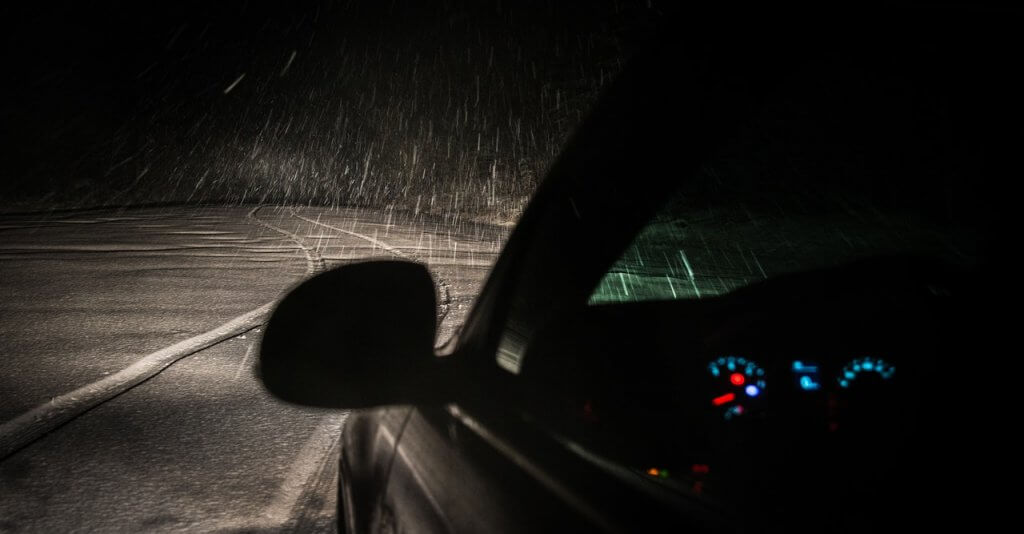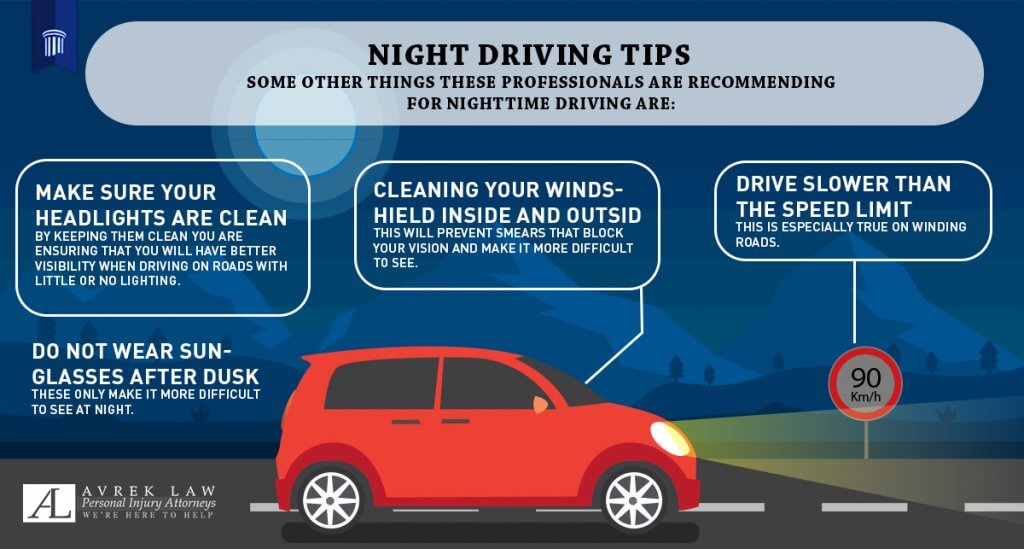Driving under poor conditions is more than just icy or wet roads. Some of the worst situations include dusk and night driving; rain, fog, snowstorms, and drifting snow; sunshine and shadows; and driving towards the sun.
Dusk
During this period of half-light, the cone central vision is not as efficient as in daylight, but your eyes are not yet prepared for night vision either. Professional drivers try not to drive during this period if they can help it. Whenever practical, they will stop and take a meal or a rest to help their eyes adapt to the dark. If you must drive, it is imperative that you reduce speed and be particularly alert.

Night Driving
At night, the eye sees people or objects by contrast – light-colored clothing or objects stand out against a darker background; or by outlining – dark clothing or objects are silhouetted against a lighter background.
People, animals, and objects are more or less visible depending on the amount of light they reflect at the observer. It is well known that light-colored clothing or objects reflect more that dark colored objects, and so will be seen from a greater distance. But a driver cannot count on other people or animals to make themselves more visible. A driver never knows when his headlights will reveal – too late – a darkly dressed pedestrian or a car parked without lights.
When driving at night, your reference point must be a little higher than the meeting point of the headlight and the pavement in the center of your lane.
Peripheral vision suffers less than central vision at night. It is very important that you train yourself to use your peripheral vision extensively when driving in daylight so that it becomes a firmly set habit that you simply carry on at night. Otherwise, you may use only your central vision in the narrow cone of light.
This concentration of the eyes and attention reduces the efficiency of the peripheral vision. The eyes would not move as they should, and, because of that lack of movement, eye fatigue may set in. As we discussed before, double or one-eyed vision may result.
Preparing Your Eyes for Night Vision
Your vision takes time to become efficient at night. It has been determined that it takes at least 30 minutes to get to 80 percent efficiency and at least one hour to reach 100 percent. You can lose a good percentage of this adaptation to the dark by just looking at streetlights or the headlights of another car. When you drive at night, therefore, always keep the following points in mind:
- When meeting a car, look to the right of the road, higher than the point where the light and pavement meet, using your peripheral vision to detect possible motion.
- Never drive at night when tired – Stop and rest.
- Remember that distance judgment is much more difficult at night because you may tend to overestimate the distance between you and other cars and underestimate your speed. You must be especially alert when judging distances to red lights – this color presents special difficulties, so allow plenty of space when following another car, and more space to stop than would seem necessary at a red traffic light.
- Traffic lights are difficult to locate in brightly lit areas. A driver should rely a great deal on this peripheral vision.
- Some drivers like to follow another vehicle at night. This is a very good method of driving, especially on strange roads, because the car in front illuminates the way for a long distance, helps to locate dangers on the shoulders by outline, and in general, helps you to keep a steady pace. However, when you follow another car, you must keep more than what appears to be a safe distance; Make sure you use your low beams only, and look on the shoulder of the road and not at the red rear lights of the car ahead – this practice has been known to put the following driver to sleep.
- Avoid smoking when driving. Smoke will reduce visual acuity and leave a film of smog on the inside of the windshield if the car is not properly ventilated.
- Have all the lights and the windshield (Inside and out) cleaned! Visibility is reduced drastically by dirt or film on the glass.
- Drive at a speed that will enable you to stop within the distance you can see clearly ahead.
Driving in Rain, Dust, Snow, and Fog
Three of these conditions present about the same problem: Rain, snow, and fog all act as a mirror. In modern cars, in which the driver sits in line with the light rays from the high beam of the headlights, the light strikes the drops of rain, droplets of fog, or the snowflakes, and is reflected back in the driver’s eyes.
It the low beams are used, the light is reflected down towards the road to give more light. In these conditions, therefore, the low beams only should be used. Fog lights are also helpful because of their extra-low position on the vehicle so that more light rays are reflected on the roadway.
Heavy vehicles with high cabins give even better visibility because of the position of the driver. It is a good habit to follow these vehicles at a proper distance on such nights.
Sunshine and Shadows
Driving in a wooded area or on city streets at the time of day when the sun makes patches of shadow with the bordering trees or houses can be very dangerous. Tinted lenses or dust on the windshield may prevent you from seeing people, animals, or objects on or close to the road or street. Reduce speed and remove your sunglasses if you are wearing them. The same advice is also applicable when entering a tunnel.
Driving Towards the Sun
When driving towards a setting sun, always use the sun visors. A dusty windshield is particularly dangerous in this case.
When driving with the sun at your back, remember that the oncoming drivers have very poor visibility. It is advisable to turn your headlights on to warn drivers heading in the opposite direction not to move into your lane.

Be careful, stay safe, and if you run into trouble, contact us!
How much is your case worth?
Get a free case evaluation